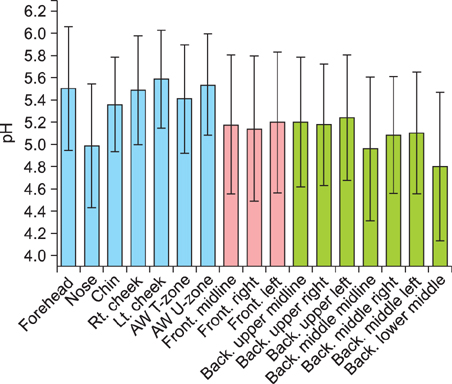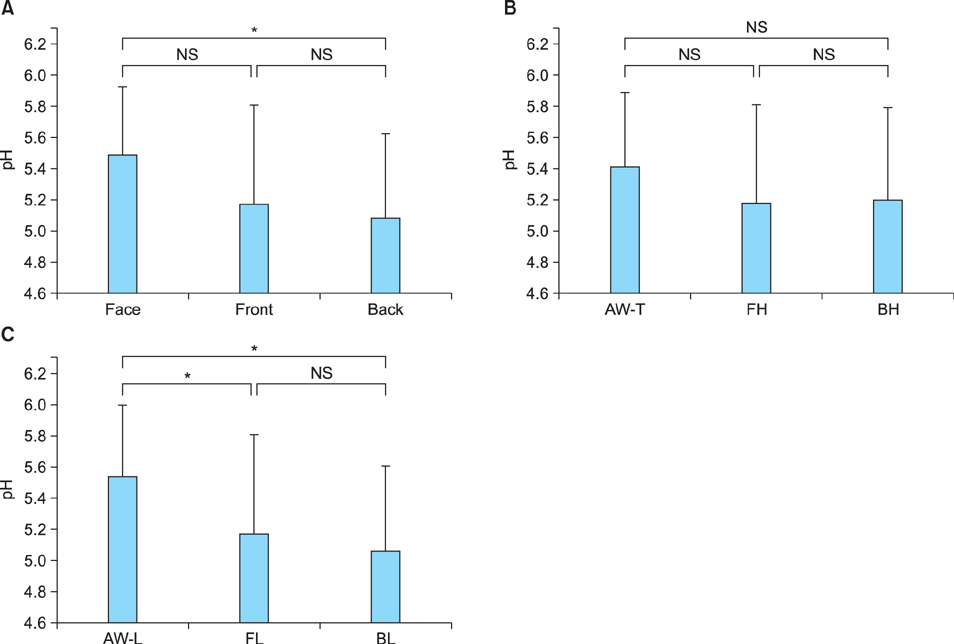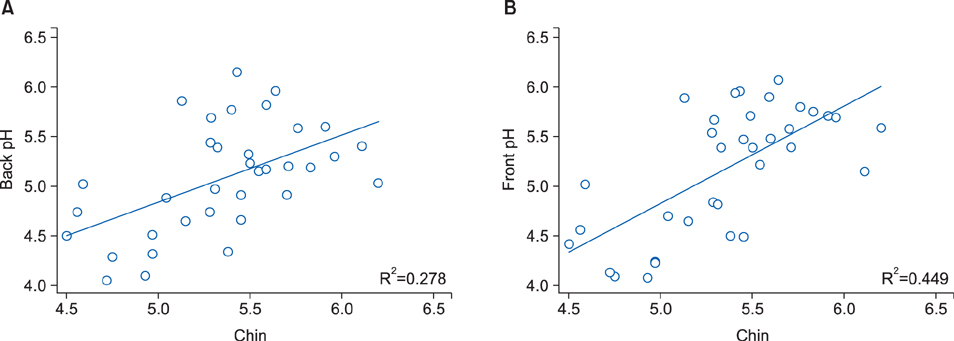Ann Dermatol.
2016 Apr;28(2):216-221. 10.5021/ad.2016.28.2.216.
Relation between pH in the Trunk and Face: Truncal pH Can Be Easily Predicted from Facial pH
- Affiliations
-
- 1Department of Dermatology, Seoul National University Bundang Hospital, Seoul National University College of Medicine, Seongnam, Korea. swyoun@snu.ac.kr
- KMID: 2171380
- DOI: http://doi.org/10.5021/ad.2016.28.2.216
Abstract
- BACKGROUND
The clinical symptoms of facial and truncal acne differ. Skin surface acidity (pH), which is affected by sebum secretions, reflects the different clinical characteristics of the face and trunk. However, no studies have been conducted on truncal sebum production and skin pH.
OBJECTIVE
We evaluated the differences and relationship between pH values of the face and trunk. We also evaluated the relationship between pH and the quantity of sebum produced in the trunk.
METHODS
A total of 35 female patients clinically diagnosed with truncal acne were included. We measured pH on the face and truncal area using the Skin-pH-Meter PH 905®. We measured truncal sebum secretions using the Sebumeter SM 815®. Statistical analysis was performed to evaluate the correlations and differences between pH and sebum.
RESULTS
Facial pH was significantly higher than chest and back pH values. The correlation between pH on the trunk and the face was significant. We used linear regression equations to estimate truncal pH using only measured pH from the chin. There was no significant relationship between truncal sebum secretion and pH.
CONCLUSION
This was the first study that evaluated the differences and correlations between facial and truncal pH. We found that facial pH can predict truncal pH. In addition, we conclude that differences in pH and sebum secretion between the face and trunk are one of the reasons for differences in acne symptom at those sites.
Keyword
- Face; pH; Sebum; Skin-pH-Meter®; Trunk
Figure
Reference
-
1. Rippke F, Schreiner V, Doering T, Maibach HI. Stratum corneum pH in atopic dermatitis: impact on skin barrier function and colonization with Staphylococcus Aureus. Am J Clin Dermatol. 2004; 5:217–223.2. Rippke F, Schreiner V, Schwanitz HJ. The acidic milieu of the horny layer: new findings on the physiology and pathophysiology of skin pH. Am J Clin Dermatol. 2002; 3:261–272.3. Kim BR, Chun MY, Kim SA, Youn SW. Sebum secretion of the trunk and the development of truncal acne in women: do truncal acne and sebum affect each other? Dermatology. 2015; 231:87–93.
Article4. Del Rosso JQ. Management of truncal acne vulgaris: current perspectives on treatment. Cutis. 2006; 77:285–289.5. Youn SH, Choi CW, Choi JW, Youn SW. The skin surface pH and its different influence on the development of acne lesion according to gender and age. Skin Res Technol. 2013; 19:131–136.
Article6. Kim MK, Choi SY, Byun HJ, Huh CH, Park KC, Patel RA, et al. Comparison of sebum secretion, skin type, pH in humans with and without acne. Arch Dermatol Res. 2006; 298:113–119.
Article7. Youn SH, Choi CW, Choi JW, Kim BR, Byun SY, Youn SW. Novel facial cosmetic area 'O zone' shows unique characteristics in sebum excretion and acne lesion distribution. Skin Res Technol. 2014; 20:164–169.
Article8. Yoon HS, Choi JW, Youn JI. Method of assessing involved facial areas: rule of fours. Br J Dermatol. 2008; 158:1022–1028.
Article9. Kim MK, Patel RA, Shinn AH, Choi SY, Byun HJ, Huh CH, et al. Evaluation of gender difference in skin type and pH. J Dermatol Sci. 2006; 41:153–156.
Article10. Schmid-Wendtner MH, Korting HC. The pH of the skin surface and its impact on the barrier function. Skin Pharmacol Physiol. 2006; 19:296–302.
Article11. Lambers H, Piessens S, Bloem A, Pronk H, Finkel P. Natural skin surface pH is on average below 5, which is beneficial for its resident flora. Int J Cosmet Sci. 2006; 28:359–370.
Article12. Greenman J. Follicular pH and the development of acne. Int J Dermatol. 1981; 20:656–658.
Article13. Elias PM. Therapeutic Implications of a Barrier-based Pathogenesis of Atopic Dermatitis. Ann Dermatol. 2010; 22:245–254.
Article14. Korting HC, Braun-Falco O. The effect of detergents on skin pH and its consequences. Clin Dermatol. 1996; 14:23–27.
Article15. Patel A, Calfee RP, Plante M, Fischer SA, Green A. Propionibacterium acnes colonization of the human shoulder. J Shoulder Elbow Surg. 2009; 18:897–902.
Article
- Full Text Links
- Actions
-
Cited
- CITED
-
- Close
- Share
- Similar articles
-
- The pH of water from various sources: an overview for recommendation for patients with atopic dermatitis
- Esophageal pH and Combined Impedance-pH Monitoring in Children
- The pH of antiseptic cleansers
- Measurements of Oral and Gastric pH in Neonates
- Comparison of blood gas analyser, pH meter and pH Strip methods in the measurement of pleural fluid pH




